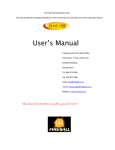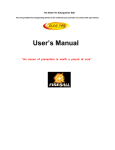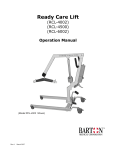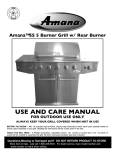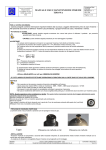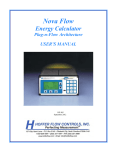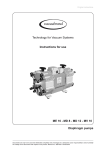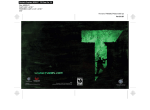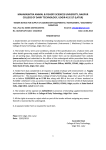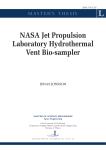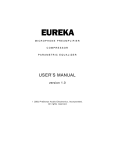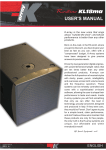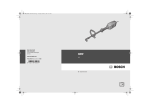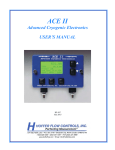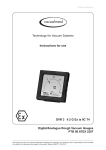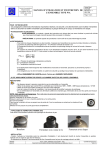Download User`s Manual
Transcript
User’s Manual The Fireball SA Fire Extinguisher Ball The only portable fire extinguishing device in the world that auto activates on contact with open flame. EZ Trade 290 cc (Fireball SA H/O) 5 Hyde Park, Platinum Crescent Marconi Beam, Milnerton,7447 Tel: 021 552 4631 Fax: 021 555 3394 Email: [email protected] Email [email protected] Email: [email protected] Website: www.fireball.co.za “An ounce of prevention is worth a pound of cure” 1|Page Fireball South Africa The Fire Extinguisher Ball Index 1. Introduction 2. The fire extinguisher ball – The device 3. How to use the fire extinguisher ball 4. Installation Guide 5. Test Manual for the fire extinguisher ball 6. Comment and reports from Steve Davies (Fire Investigator Metropolitan Fire service Australia) 7. Material Safety Data sheet 8. Frequently asked questions 9. Inspection checklist 10. Awarded and Recognized by 11. Closing comments 2|Page 1. Introduction: The Fireball SA - Fire Extinguisher Ball All fire safety guidelines rely on the risk that is been protected. Prior to protecting the fire risk we should assess the area and the situation. In South Africa specific regulations and guidelines are available. These guidelines are therefore the rational design for building regulations The Fire Extinguisher Ball is a simple yet life saving, cost effective device that will increase the service delivery to the South African market. The fire extinguisher ball is the only self activating portable device that auto activates when in contact with open flames. 3|Page 2. The Fire Extinguisher Ball - INDOOR USE ONLY A device utilizing a small non lethal explosive mechanism for use against all small types and classes of fires. The force of the bursting device is not harmful to humans, animals or property and further minimized through the use of low density/ low mass components. No part of the device having sufficient mass or density to neither constitute a ballistic hazard nor be hazardous in concussive shock due to bursting effect. The product is composed of a lightweight casing of frangible material. With a protective exterior sheathing. Within the internal cavity of the device a pyrotechnic detonator is located at or near the centre of mass and is activated by fuse cords extending from the interior to the exterior surfaces filled with dry chemical powder called mono ammonium phosphate a non conductive material so can be used on any electrical product with no resulting damage. Fireball will auto activate on direct contact with open flames (not heat) Upon activation the fireball will emit a loud bang of between 119-120db and disperse a dry chemical powder (mono ammonium phosphate) that will effectively extinguish the fire. The Fireball can be rolled or thrown into a fire, it will auto activate within 3-7 seconds Fireball can be wall mounted and effectively placed to put out small fires caused by: Electrical shortages Fat, Oil and Paraffin on stoves Fires in vehicles Workshops and factories Fireball’s main features include: It’s the only patented portable fire extinguisher device in the world that: Auto activates with open flames. Upon activation it emits a loud bang. It is light weight only 1, 3 kg making it easy to handle and operate. It requires no maintenance, refilling, servicing or pressure testing and hence it has a maintenance free lifespan of 5 years and thus a very cost effective product. You don’t have to get close to the fire; you can simply roll it from a distance thus eliminating the chance of fire related injuries. Light weight easy to operate and hence ideal fire extinguisher for the elderly, infirm and children. 4|Page 33. How to use the Fireball SA Fire Extinguisher Ball The Fire extinguishing Ball will extinguish the following fires Class A fires – Fires involving carbonaceous solids such as Wood, cloth, paper, rubber and plastic Class B fires – Fire involving flammable and combustible liquids Class C fires – Fire involving electricity Fireball is harmless to humans yet it makes a loud bang enabling you or your neighbors to be aware of the presence of fire and thus acts as a fire alarm. The fireball can be rolled or thrown into a fire; it will burst within 3-7 seconds extinguishing the fire instantly. You don’t have to get close to the fire. Fireball can be kept on a shelf or wall mounted bracket for easy reach. The Fireball installed in a wall mounted bracket will self activate in the presence of open flames and extinguish the fire and hence protect the area when no human is present, therefore ideal for holiday homes, warehouse and offices after hours, etc It is your 24 hour fire sentry always on guard and protecting you and your property from fire. Please check SABS test report For Indoor use only 5|Page 4. Installation Guide Prior to installation of the fire extinguishing ball please note the following A fire safety assessment needs to be done to ensure the effectiveness of the fire extinguishing ball. Fire hazards in the home or office environment need to be: 1. Identified 2. Evaluated 3. Eliminated 4. Controlled 4.1 The following questions should be asked a) Where is a fire most likely to start? (Electrical points, geysers, heaters, stove tops, fireplaces, kitchens, garages, workshops, near flammable liquids, ceilings, down light points, etc) b) Will the fire spread rapidly through the building or home? Also in which direction will the fire spread, due to drafts and combustible fuels c) Will the fire extinguishing balls installed at the identified hazardous areas be sufficient to effectively extinguish the fire when it starts? d) What is the floor area or volume you are trying to protect? e) What is the risk you are trying to protect? f) Is pressure ventilation present in this area? g) Is the electrical “trip” switch in order? Will it “trip” and cut the electricity supply in the event of fire? h) Is the housekeeping in order? i) Escape routes in the event of fire and is it INDOORS? j) Fire risk of products located in the room or environment? k) Where will the occupants run for a fire extinguishing device in the event of a fire? l) Places that need attention are; Kitchens: gas and electrical stove tops Over any chip fryers or heating equipment Electrical products or power points that are over loaded Electrical distribution box Cupboards containing flammable liquids Open indoor cooking areas like indoor braai's Bedrooms: Next to bed for easy use Over any loaded power points or where heaters are situated General living areas: Over fire places Computer rooms, alarm centre In ceilings next to geyser and to stop fire jumping rooms via roof Next to down lights and over loaded lighting fixtures and connections Install next to front and back doors for easy evacuation and easy entry Install in passage so that close proximity to all rooms 6|Page Over or in safe where valuable documents and property stored In middle of room if away from premises for long period of time Garage area: Over any flammable liquids (fuel, paints, cleaning liquids etc) Over vehicle (above vehicle) Over loaded power points Other areas: Pool or borehole pump houses Generator rooms Wine cellars Braai areas (over wood stocks), smoking areas Can be kept in motor vehicle in case of accidental engine fire Over gas bottle storage area In store rooms AND ALL ATTICS Over garbage areas if enclosed by at least 3 walls and has a ceiling PLEASE REMEMBER THIS PRODUCT IS FOR INDOOR USE ONLY 4.2 Installing your Fire Extinguishing Ball: 1. 20-80 cm above hazardous areas or devices. To give maximum effectiveness in case of fire 2. The fire extinguisher ball will self activate when in contact with open flame 3. Wall mounts at 1m above all flammable liquid for class B fires 4. Wall mounts at 10cm above electrical distribution points for class C fires 5. Make sure arrows always points upwards 6. For class B fires NEVER throw the ball into the fire 7. Avoid exposure to sunlight, moisture and humidity 8. All balls can cover 1.296 cubic meters which is an area of 4 to 6 square meters 9. Must be INDOORS this is not for use outdoors In case of fires bigger than 2.596 cubic meters or that has been burning for more than 6 minutes throw 2 balls into the fire for best efficiency. WE OFFER A FREE RISK ASSESSMENT SERVICE FOR THE FIRE EXTINGUISHING BALL. PLEASE CONTACT OUR RISK ASSESSMENT MANAGER AND HE WILL ADVISE SUITABLE INSTALLATION DETAILS PERTAINING TO YOUR CUSTOM REQUIREMENTS 7|Page 55. Test Manual Fireball SA Fire Extinguisher ball The following tests were conducted on the fire extinguisher ball 1. Fire extinguishment class A fires – Passed 2. Fire extinguishment class B fires - Passed 3. Fire extinguishment class C fires – Passed In all tests upon activation of the fire extinguishing ball all flames were fully extinguished 4. Thermal resistance test The Fireball was placed in an oven with air circulation capability and temperature inside the oven was at 85C for 24hrs + 15min. Ball did not activate, proving that ball does not react to heat but to open flame only. Thus proven to be safe against faulty activation and will only activate in the presence of fire and thus avoid false alarms. The ball was inspected immediately upon removal no cracks tears or leakage of extinguishing agent were observed– Passed 5. Burst effect test The container with dimensions of 56x56x56cm was constructed with a strong frame and 5mm thick normal glasses for 5 sides and open on the top – after activation of the ball, no cracks or shattering of glass panels were observed – Passed Also activated next to 3 average inflated children party balloons. No balloons popped or where damaged due to the burst effect thus proving that the burst effect is not harmful to humans, animals or property. 6. Sound level tested 127Db – Passed 7. Compression resistance test Compression load with speed of 5mm/min was applied to the ball until it reached the load of 150kg and the load was constant for 10min The ball was inspected immediately upon removal of wrapper, no cracks, tears or leakage of extinguisher agent were observed – Passed 8. Drop test Fireball was dropped from a height of 2.5m on a cement floor. With inspection of the ball after each drop no cracks tears of leakage of extinguisher agent was observed on all balls tested- Passed Several fires were made inside an iron shed. Three balls were thrown into the shed only one activated and extinguished the fire. The other two balls did not activate and could be reused. Test conducted by PSB Corporation (test reports available upon request) Test and reports were also conducted by Sirim Qas International AcGih Worldwide (test reports available upon request) Device approved and classified by South African Police services (certificate available on request) 8|Page 6. Comment and report from Steve Davies – Fire Investigator Metropolitan Fire Service Australia 6.1 Qualities and benefits of the Fire Extinguishing Ball 1. 5 Year shelf life, then a 20% less effectiveness – (can be used as a secondary device) 2. Friction will not operate the device 3. Activeness at approx 85c direct flame contact 4. At 280c + will activate device non flame contact 5. If it leaks of is broken- bury it in the ground as it is Biodegradable (Polystyrene Ball not biodegradable) 6. Contents is ammonia phosphate and salt 7. Loud band approx: 128 decibel when activated- fine white powder dispersed 8. Main ball is made of polystyrene 9. Has a slow burning heat sensitive fuse Report available on request 6.2 General Information The fire extinguisher ball is a ball shaped fire extinguisher, simply throw ball into fire it will self activate within 3-10 seconds and effectively disperse fire extinguishing chemicals in a 360 degree radius over a 4-6 square meter diameter If a fire occurs and no one is present the fire extinguisher ball will self activate when it comes into contact with open flames and simultaneously produce a loud bang acting as a fire alarm 9|Page 7. Material Safety data sheet for extinguishing powder According to 91/155 EC 1. Identification of substance: - Product details - Trade name: Furex 770 - Manufacturer/ Supplier: Caldic Deutschland GmbH & Co.KG Am Karishof 10, 40231 Dusseldorf Telephone: (0211) 7346-2 88 Fax: (0211) 7346-2 72 Informing department: Product Safety department 2. Composition/Data on components: - Chemical characterization - Description: Mixture of the substances listed below with harmless additions - Dangerous components: Void 3. Hazards identifications - Hazard designation: Void - Information pertaining to particular dangers for man and environment: Void - Classification system The classification is in line with current EC lists. It is expanded, however, by information From technical literature and by information furnished by supplier companies 4. First aid measures - General information no special measures required - After installation supply fresh air: consult doctor in case of symptoms - After skin contact the product is not skin irritating - After eye contact rinse opened eye for several minutes under running water - After swallowing in case of persistent symptoms consult the doctor 5. Fire fighting measures - Suitable extinguishing agents use fire fitting measures that suit the environment - Productive equipment: No special measures required 6. Accidental release measures - Person-related safety precautions: No special measures required - Measures for cleaning/ collecting: No special measures, Collect mechanically - Additional information: No dangerous materials are released 7. Handling and storage - Handling - Information for safe handling : No special measures required 10 | P a g e - Information about protection against defection and fires: No special measures required - Storage - Requirements to be met by storerooms and containers - Use only containers specifically permitted for this substance/product - Information about storage in one common storage facility: Not required - Further information about storage conditions: Store under dry conditions 8. Exposure controls and personal protections - Additional information about design of technical systems: No further data (see item 7) - Components with critical values that require monitoring at the workplace: - 7727-43-7 barium sulphate, natural (2-5-10%) - TLV 2 mg/m3 - Additional information: The list that were valid during the compilation were used as basis - Personal protection equipment - General protective and hygienic measures - The usual precautionary measures should be adhered to in handling the chemicals - Breathing equipment: Not required - Protection of hands: Not required - Eye protection; Not required 9. Physical and chemical properties: - Form: Solid - Colour: According to product specification - Smell: Characteristic - Change in condition - Melting point/Melting range: Not determined - Boiling point/Boiling range: Not determined - Flash point: Not applicable - Self-in flammability: Product is not self igniting - Danger of explosion: Product is not explosive - Density at 20C: 1.347 g/cm3 - Density in Miscibility with Water: Unsalable 10. Stability and reactivity Thermal decomposition/conditions to be avoided: No decompositions if used according to specifications Dangerous reactions: No dangerous reactions known Dangerous products of compositions: No dangerous decomposition products known 11. Toxicological information - Acute toxicity: - Primary irritant effect: - On skin: No irritant effect - On the eye: No irritant effect - Sensitization: No sensitizing effect known - Additional toxicological information 11 | P a g e - The product is not subject to classification according to the calculation method of the General EC Classification Guidelines for Preparations as issued in the latest version: - When used and handled according to specifications the product does not have any Harmful effects according to our experience and the information provided to us 12. Ecological information - General notes: Generally not hazardous for water 13. Disposal consideration: - Product: Recommendation Contract waste processors for recycling information - Unclean packaging: - Recommendation: Disposal must be made according to official regulations 14. Transport information - No hazardous product - Land transport ADR/RID and GGVS/GGVE (cross border/domestic) - ADR/RID-GGVS/E class: 15. Regulatory information - Designation according to EC guidelines: - Observe the normal safety regulations when handling chemicals - The product is not subject to identification regulations under EC Directives and the Ordinance on Hazardous Materials ( GefStoffV) - Code letter and hazard designation of product: Nicht eingestufti - National regulations - Water hazard class: Generally not hazardous for water 16. Other information These data are based in our present knowledge. However they shall not constitute a guarantee for specific product features and shall not establish a legally valid contractual relationship. Department issuing data specification sheet: Environment protections department Contact: CALDIC Deutschland GmbH & Co. KG Further in depth technical specifications on all components of the fire extinguishing ball is available from our risk assessment manager. Please feel free to contact and discuss with our risk assessment manger any technical specifications you may have on the product. 12 | P a g e 9. Frequently asked Questions: Q: Is the Burst effect dangerous / harmless? A: No the ball is harmless to people, animals and property. The shell of the Fireball is made of expanded foam (polyethylene). The powder that is dispersed is mono-ammonium phosphate. (NonToxic) Q: Where can I refill the ball after 5 years? A: Fireball is not refillable it has a lifespan of 5 years maintenance free Q: How do I go about replacing the ball? A: The Fireball is available throughout South Africa from dealerships and agents that will assist in order and replacement procedure, alternatively contact Fireball South Africa Head office: 021 552 4631 Q: Will the ball activate if in contact with heat? A: NO, ball can with stand heat of up to 200 degrees and will not activate. The ball auto activates only when in contact with open flames (Tests have been conducted on heat exposure) Q: Where can I install the ball? A: Fireball South Africa Dealer and agents will assist you with evaluation and installation with the Risk Assessment Manager. Q: What types of fires can fire ball extinguish? A: The chemical extinguishes on Class A Fires: Fires involving wood, paper and plastics Class B Fires: Fires involving flammable liquids like paraffin And Class C Fires: Fires involving electrical equipment The Fireball can also be rolled or thrown into a fire the ball will burst within 3-7 seconds after coming in contact with open flames and extinguish the fire Q: Can the ball be installed on the outside of the building? A: No it is for indoor use only. 13 | P a g e Frequently asked questions continue.... Q: Can I throw the ball in a drum of flammable liquid? A: No do not throw the ball into flammable liquid as spillage will spread the fire. Q: What size fire the Fireball extinguish A: Fireball can extinguish a fire of approx 4-6square meters, please check SABS test report for fire ratings Q: Does Fireball stop or prevent fires? A: Fireballs are design to extinguish the fire as it starts and stop the fire before it spreads or increases in size and thus it stops the fire when correctly installed. Q: If the Fireball falls and is damaged will it still activate? A: Fireball passed the drop test. Please inspect the ball immediately for damages or leakages of powder after fall. In the unlikely event of damage and there is a spillage of powder the ball must be replaced as its effectiveness cant then be sustained We at Fireball South Africa will assist you with any further information you need to protect your property against fires. Fireball has a fulltime qualified risk assessment manager who specialises in fire related risks and who is willing to assist you with all matters relating to the Fire Extinguishing ball. The Fireball is an effective device in your fire prevention program 14 | P a g e Fireball South Africa Inspection Checklist Time: _______________________________ Date: Company name: _______________________________ Email: _________________________ Address: email: _______________________________ Opening Time : _______________________________ Closing: ________________________ Owner: _______________________________ Manager: _______________________ Client Name Signature _________________________ Yes/ No Remark Building: Storeys: Occupancy: Occupants: Roof assembly: Construction type: Basement/Loft: Stairways: Internal: External: Ventilation: Clear space: Obstructions: Fire hose reels: Fire Hydrants: Sprinkler system: Smoke detection: Escape/Emergency: Emergency exits: Emergency routes: Emergency doors: Emergency Lights: Fire detection: Fire alarm: Emergency Evacuation plan: Emergency no: 15 | P a g e 1 Client Name Signature Yes/No Remark Fire Equipment: Sufficiency: Condition: Signage: Service Record: Service date: Ventilation: Is the fire likely to spread in building or property? Flammable liquid: Hazardous substances: Floor coverage: Rubble: Storage: Stacking: Earth leakage: Electrical: Installation: Certification: Fire Co-ordinator: Staff Training Fireballs: Installation: Elevators: Roller doors: 1st Floor 2nd Floor Comments: _______________________________________________________________________ _______________________________________________________________________ _______________________________________________________________________ _______________________________________________________________________ Management signature: __________________________ Agent Signature:______________________ 16 | P a g e Your active fire fighter 24/7 11. Closing Comment I believe after reading the manual there would be questions regarding the fire extinguisher ball. We at Fireball South Africa are always at your disposal and will gladly provide further information, installation and general support. When you implement this device you should bear in mind that all systems and devices have Their limitations and you should remember this with the fire extinguisher ball it is not the solution to all fire problems. The Fire extinguisher ball is available throughout South Africa therefore we use the Information on the web site to support our clients in South Africa. We are looking forward to hearing from you soon. Keep well and let us fight fires together. 17 | P a g e M. Möller Risk Assessment Manager Fireball South Africa 18 | P a g e


















